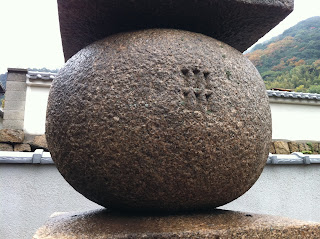There are 19 temples in Tomo. Considering the fact that the town is 600 meters wide from east to west and less than 1 kilometer from north to south, this number is quite large. It is believed that there were nearly 30 temples in the Edo period when the town was prosperous with transit trading.
The oldest is said to be Jokan-ji built around 810 followed by Io-ji on the hill allegedly founded in 826 by Kukai, a great Buddhist monk and cultural hero who, according to local legends, dug wells and built temples instantly. Tomo is likely to have had at least three temples in the ninth century including these two and the other which does not exist anymore.
 |
| Ankoku-ji Shaka-do (Sakyamuni Hall) |
Ankoku-ji, originally built in the 13th century under a different name, was renamed in the 14 century by ASHIKAGA Takauji, who ordered the construction of Ankoku-ji temples and Risho-to towers nationwide wishing for the repose of the war dead. The temples and towers were especially dedicated to the late Emperor Godaigo, who was opposed to Takauji and escaped to Yoshino, Nara where he died in frustration.
 |
| Amitabha trio See the attendants' elegant hand postures |
Ankoku-ji’’s high status didn’t allow it to have parishioners as financial supporters. Sometimes the temple was in dire situation. Historically and academically, however, this is an important temple. The Shaka-do (Sakyamuni Hall) that enshrines not the Sakyamuni trio but the trio of Amitabha Buddha and his attendants is a significant example of architecture from the 13th century which utilized techniques introduced from Buddhist monks and others fleeing Sung China whose authority was waning and about to be replaced by Yuan Dynasty.
 |
| Part of the stately tomb stone at Ankoku-ji, built by a merchant family in the Edo period |
FUKUSHIMA Masanori expanded the already-existing fortress into Tomo Castle. The central citadel was built on top of the hill now situated in the middle of the historic area of Tomo. In those days, the castle stood at the edge of the land but the seashore has receded due to reclamation. The lord too reclaimed some land and that's how Taiga-shima island became part of the main land. He moved Enpuku-ji temple from its original location onto the hill of the former island, a vantage point to overlook the waters and the location of a stronghold during the middle ages.
The construction of the castle town continued and the planning was grand, which made TOKUGAWA Ieyasu upset and skeptical about his loyalty, leading to the demolition of the castle probably in 1609.
Walk along the temples and see some of your favorites carefully, thinking about the lord who was not a true sympathizer of the Tokugawa clan and demoted to a smaller domain after his short reign in Hiroshima.
 |
| Io-ji on the hill |
No comments:
Post a Comment